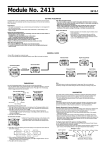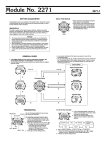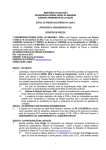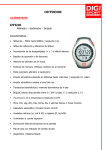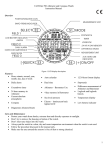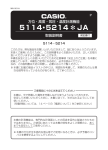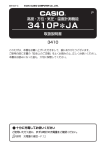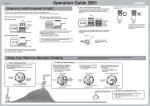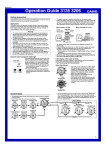Download Casio 2273 Watch User Manual
Transcript
Module No. 2273 GETTING ACQUAINTED 2273-1 About This Manual • Button operations are indicated using the letters shown in the illustration. • Each section of this manual provides you with the information you need to perform operations in each mode. Further details and technical information can be found in the “REFERENCE” section. Congratulations upon your selection of this CASIO watch. To get the most out of your purchase, be sure to read this manual carefully and keep it on hand for later reference when necessary. Warning! • The measurement functions built into this watch are not intended for taking measurements that require professional or industrial precision. Values produced by this watch should be considered as reasonable representations only. • When using this watch to take readings while boating or engaging in any other activity during which losing your way can create a dangerous or life-threatening situation, always be sure to use a second compass to confirm direction readings. • The longitude, lunitidal interval, Moon phase indicator, and tide graph data that appears on the display of this watch is not intended for navigation purposes. Always use proper instruments and resources to obtain data for navigation purposes. • This watch is not an instrument for calculating low tide and high tide times. The Tide Graph of this watch is intended to provide a reasonable approximation of tidal movements only. • CASIO COMPUTER CO., LTD. assumes no responsibility for any loss, or any claims by third parties that may arise through the use of this watch. (Light) GENERAL GUIDE • If the digital display of your watch is continuously changing, see “Auto Display Function” for information on how to stop it. • The illustration below shows which buttons you need to press to navigate between modes. • Press B to enter the Digital Compass Mode or C to enter the Barometer/ Thermometer Mode from the Timekeeping Mode or Countdown Timer/ Stopwatch Mode. To get to a sensor mode from the Moon/Tide or Alarm Mode, you must go to the Timekeeping Mode first. Sensor Mode Timekeeping Mode Digital Compass Mode Press B or C. ▲ ▲ ▲ Press D. Press D. ▲ ▲ Countdown Timer/Stopwatch Mode Press B. Press B or C. ▲ ▲ Press D. Press C. ▲ D Barometer/ Thermometer Mode D ▲ Alarm Mode ▲ Moon/Tide Mode D TIMEKEEPING Moon phase indicator Day of week Tide graph Hour : Minutes Important! • The watch cannot produce correct Moon phase or tide graph data unless the Timekeeping Mode current time and date settings, as well as city data settings (GMT differential, longitudes, and lunitidal interval) Seconds are all correct. Year Month – Day PM indicator In addition to normal timekeeping, use the Timekeeping Mode to set the current time and date. • The Moon phase indicator shows the current Moon phase. • The tide graph shows the current tidal movements. • Having the batteries replaced causes the Timekeeping Mode’s time/date and city data settings to revert to their initial factory default settings. Use the following procedure to set the current time and date, and to make city data settings. To reset the seconds count to zero 1. In the Timekeeping Mode, hold down A until the second’s digits start to flash, which indicates the setting screen. 2. Press E to reset the seconds count to 00. • Pressing E while the seconds count is in the range of 30 to 59 resets the seconds to 00 and add 1 to the minutes. In the range of 00 to 29, the minutes count is unchanged. 3. Press A twice to exit the setting screen. 2273-2 To take a direction reading Day 12/24-Hour Format Minutes Hour Month Year SS S Note • Note that taking a measurement while the watch is not horizontal (in relation to the horizon) can result in large measurement error. • Pressing B while in the Digital Compass Mode starts a new direction measurement operation. • The following table shows the meanings of each of the direction abbreviations that appear on the display. Direction Meaning To configure city data settings 1. In the Timekeeping Mode, hold down A until the second’s digits starts to flash, which indicates the setting screen. 2. Press A again to display the city data setting screen, with the GMT differential flashing. • Press D to move the flashing in the sequence shown below to select other settings. Lunitidal Interval Longitude E The Moon phase and tide graph information displayed by this watch differ according to your geographic location. Before using this watch to produce such information, be sure to make the proper city data settings to specify your current location. • The lunitidal interval is the time elapsing between the Moon’s transit over the meridian and the next high tide. See “Lunitidal Interval” for more information. • This watch displays lunitidal intervals in term of hours and minutes. • GMT differential is the difference between the time in the displayed time and Greenwich Mean Time (GMT). GMT Differential E NE ENE Configuring City Data Settings GMT Differential NN 3. While the hour, minutes, year, month, or day setting is flashing, use E (+) and B (–) to change it. • When the 12/24-hour setting is flashing, press E to toggle between ) and 24-hour ( ) timekeeping. 12-hour ( 4. Press A twice to exit the setting screen. Magnetic North Pointer E SE SSE ES Seconds 1. Enter the Digital Compass Mode. 2. Place the watch on a flat surface or (if you are wearing the watch) make sure that your Direction wrist is horizontal (in relation to the horizon). 3. Point the 12 o’clock position of the watch in the direction you want to determine. 4. Press B to start a Digital Compass reading operation. • After about two seconds, the direction that the 12 o’clock position of the watch is pointing appears on the display. • Also, four pointers appear to indicate magnetic north, south, east, and west. Timekeeping Mode time • Direction reading continues for the amount of time that is currently Direction value (in degrees) specified for the continuous reading N NW time. NW W WN 0° N • The COMP indicator flashes on the display while a reading is in progress. • The direction value that appears on the display represents the clockwise angle formed between magnetic north (which is 0 degrees) and the displayed direction. 12 o’clock position W 1. In the Timekeeping Mode, hold down A until the second’s digits start to flash, which indicates the setting screen. • While the second’s digits are flashing, press E to reset the seconds count to 00. 2. Press D to move the flashing in the sequence shown below to select other settings. W SW WSW To set the time and date Hours Minutes 3. Use E (+) and B (–) to change the setting of the currently selected (flashing) item. • The “CITY DATA LIST” provides city data information for a number of GMT differentials, longitudes, and lunitidal intervals around the world. • You can change the GMT differential setting in units of 0.5 (half an hour). • Longitude can be specified in the range of 179°W to 180°E, in 1-degree steps. 4. Press A to exit the setting screen. Direction North East South West Direction bezel Meaning Direction Meaning Direction Meaning NorthEastNortheast northeast northeast EastSouthSoutheast southeast southeast SouthWestSouthwest southwest southwest WestNorthNorthwest northwest northwest • You can adjust the rotary direction bezel so that the “ ” (or “N”) is aligned with the magnetic north pointer. This correctly aligns all of the markings on the bezel. • The Digital Compass operation is momentarily interrupted while an alarm (Daily Alarm or Hourly Time Signal) or beep (progress or time up beeper) is sounding, or while the backlight is turned on by the Auto Light Switch. If this happens, start the Digital Compass operation again from the beginning. • See “Digital Compass Precautions” for other important information about taking direction readings. Making Digital Compass Settings DIGITAL COMPASS A built-in bearing sensor detects magnetic north and indicates one of 16 directions on the display. Direction readings are performed in the Digital Compass Mode. • You can calibrate the bearing sensor if you suspect the direction reading is incorrect. To enter and exit the Digital Compass Mode While in the Timekeeping, Barometer/Thermometer, or Countdown Timer/ Stopwatch Mode, press B to enter the Digital Compass Mode. • At this time, the watch immediately starts a Digital Compass operation. After about two seconds, letters appear on the display to indicate the direction that the 12 o’clock position of the watch is pointing. • Press D to return to the Timekeeping Mode. You can set up the watch so it takes continuous direction readings for an amount of time specified by you. To configure the Digital Compass Mode 1. In the Digital Compass Mode, hold down A until the upper display area shows , which indicates the setting screen. 2. Press D twice to display the continuous reading time setting screen. 3. While the continuous reading time digits are selected (flashing), use E (+) and B (–) to change the setting in increments of 10 seconds. • You can specify a continuous reading time in the range of 0'00'' to 1'00''. Setting 0'00'' causes digital compass operation to stop after a single reading. 4. Press A to exit the setting screen. 2273-3 BAROMETER/THERMOMETER This watch uses a pressure sensor to measure air pressure (barometric pressure) and a temperature sensor to measure a temperature. • You can calibrate the temperature sensor and the pressure sensor if you suspect that readings are incorrect. Understanding the Barometer/Thermometer Screen Barometric pressure graph (unit: 1hPa (mb)/0.05inHg) Temperature Barometric pressure Press C to enter the Barometer/Thermometer Mode. • Barometric pressure is displayed in units of 1hPa/mb (or 0.05inHg). • Temperature is displayed in units of 0.1°C (or 0.2°F). • The displayed barometric pressure value changes to xxxx hPa/mb (or inHg) if a measured barometric pressure falls outside the range of 260hPa/mb to 1100hPa/mb (7.65inHg to 32.45inHg). The barometric pressure value will be displayed again as soon as the measured barometric pressure is within the allowable range. • The displayed temperature value changes to xx. x °C (or °F) if a measured temperature falls outside the range of –10.0°C to 60.0°C (14.0°F to 140.0°F). The temperature value will be displayed again as soon as the measured temperature is within the allowable range. • Some countries refer to the barometric pressure unit hecto-pascal (hPa) as millibars (mb). It really makes no difference, because 1hPa = 1mb. In this manual, we use hPa/mb or hPa (mb). Barometric Pressure Graph Barometric pressure indicates changes in the atmosphere. By monitoring these changes you can predict the weather with reasonable accuracy. The barometric pressure graph shows the barometric readings for the past 26 hours. The flashing point on the right of the display is the point for the newest measurement. Note that pressure graph readings are relative to the newest measurement point. One dot above the newest point is plus 1hPa(mb)/ 0.05inHg, while one dot below is minus 1hPa(mb)/0.05inHg. The following shows how to interpret the data that appears on the barometric pressure graph. A rising graph generally means improving weather. A falling graph generally means deteriorating weather. About Barometric and Temperature Measurements • Barometric pressure and temperature measurement operations are performed as soon as you enter the Barometer/Thermometer Mode. After that, temperature measurements are taken every five seconds for the first three minutes, and then taken every five minutes thereafter. • The BARO indicator flashes on the display while a measurement is in progress. • The barometer automatically takes measurements every two hours (starting from midnight), regardless of what mode you are in. The results of these measurements are used for the barometric pressure graph. • You can also perform a barometric pressure and temperature measurement at any time by pressing C in the Barometer/Thermometer Mode. Barometer and Thermometer Precautions • The pressure sensor built into this watch measures changes in air pressure, which you can then apply to your own weather predictions. It is not intended for use as a precision instrument in official weather prediction or reporting applications. • Sudden temperature changes can affect pressure sensor readings. • Temperature measurements are affected by your body temperature (while you are wearing the watch), direct sunlight, and moisture. To achieve a more accurate temperature measurement, remove the watch from your wrist, place it in a well ventilated location out of direct sunlight, and wipe off all moisture from the case. It takes approximately 20 to 30 minutes for the case of the watch to reach the actual surrounding temperature. • You can change the measured barometric pressure unit between hectopascals/millibars (hPa/mb) and inchesHg (inHg). See “Changing the Barometric Pressure and Temperature Units” for details. • You can change the measured temperature value displayed by this watch between Celsius (°C) and Fahrenheit (°F). See “Changing the Barometric Pressure and Temperature Units”. With the countdown timer, you can set a start time in the range of 1 to 60 minutes, and countdown the time to zero. A beeper sounds each second of the final 10 seconds of a countdown, and you can also turn on a progress beeper that beeps at various times during a countdown. All of this makes the countdown timer a valuable tool for timing the start of a yacht race. • The countdown timer also can be used as a stopwatch to measure elapsed time, split time, and two finishes. See “STOPWATCH” for more information. • All the operations in this section are performed in the Countdown Timer/ Stopwatch Mode, which you can enter by pressing D. Configuring the Countdown Timer You need to make the settings listed below before actually using the Countdown Timer for timing. • Countdown start time and reset time • Auto repeat/repeat, progress beeper on/off • Graphic on/off Reset time You can set a “reset time,” which is a kind of alternate countdown start time you can recall with the press of a button any time a countdown operation is in progress. After recalling the reset time, you can press E to restart the countdown operation from the recalled reset time. Auto Repeat and Repeat The countdown timer gives you a choice of two different repeat modes: auto repeat and repeat. Auto Repeat When auto repeat is turned on, the countdown automatically restarts from the countdown start time whenever it reaches zero. Note • Even if you start a countdown operation from the reset time, the countdown automatically restarts from the countdown start time whenever it reaches zero. • Auto repeat timing repeats 100 times or until you press E to stop the countdown. • Auto repeat timing is best when timing the starts of match races. Repeat Timing When repeat timing is turned on, the watch automatically switches to the Stopwatch Mode and starts stopwatch timing when the end of the countdown is reached. ▲ Note that if there are sudden changes in weather or temperature, the graph line of past measurements may run off the top or bottom of the display. The entire graph will become visible once barometric conditions stabilize. Not visible on The following conditions cause the barometric pressure the display. measurement to be skipped, with the corresponding point on the barometric pressure graph being left blank. • Barometric reading that is out of range (260hPa/mb to 1100hPa/mb or 7.65inHg to 32.45inHg) • Sensor malfunction • Dead batteries COUNTDOWN TIMER Countdown Timer Mode Stopwatch Mode Note Repeat timing is best when timing the speed of yachts during ocean races. To set the countdown start time and reset time Countdown start time setting indicator Timekeeping Mode time 1. While in the Countdown Timer/Stopwatch Mode, hold down A until the time setting starts to flash, which indicates the setting screen. indicator to • This causes the appear on the display. 2. While the countdown start time setting is flashing, use E (+) and B (–) to change it in one-minute increments. • You must set a countdown start time in the range of 1'00" to 60'00". 3. Press D to display the reset time setting screen. • The indicator in the upper display area to to changes from indicate the reset time setting screen. 4. While the reset time is flashing, use E (+) and B (–) to change it in oneminute increments. • You can set a reset time in the range of 1'00" to 5'00". 5. After making the setting you want, press A to exit the setting screen. Important! The reset time setting must be less than the countdown start time setting. 2273-4 Countdown Mode Beeper Operations Countdown/Stopwatch Graphics The watch beeps at various times during a countdown to keep you informed about the countdown status without looking at the display. The following describes the types of beeper operations the watch performs during a countdown. Graphic indicators move in a counter-clockwise direction during countdown timer operation and clockwise during stopwatch operation. • The zero point for both the minute’s indicator and the second’s indicator is the 12 o’clock position. • The factory default setting is graphics turned off. Countdown End Beeper The watch beeps each second of the final 10 seconds before a countdown reaches zero, and at zero. The first five beeps (seconds 10 through 6) are higher pitched than the final five beeps (seconds 5 through 1). The watch emits a longer beep to signal when the countdown reaches zero. Countdown Graphics Second’s indicator Note The countdown end beeper always sounds, regardless of the on/off status of the progress beeper. Progress Beeper The term “progress beeper” actually includes two beepers: a reset time beeper and a reset period progress beeper. • During a countdown operation, the graphic indicators move counter-clockwise. • One revolution of the second’s indicator represents 10 seconds. • The minute’s indicator appears when the countdown time is 10 minutes or less. The minute’s indicator advances one step with each full revolution of the second’s indicator. One revolution of the minute’s indicator represents 10 minutes. Minute’s indicator Note The reset time beeper and reset period progress beeper sound only while the progress beeper is turned on. Stopwatch Graphics Second’s indicator • Reset Time Beeper The reset time beeper is similar to the countdown end beeper. When the progress beeper is turned on, the watch beeps each second of the final 10 seconds before the countdown reaches the reset time. • Reset Period Progress Beeper The reset period is the portion of the countdown between the reset time and zero. When the progress beeper is turned on, the watch emits fours short beeps at the top of each minute during the reset period. Example 1 Countdown Start Time: 10'00" Reset Time: 5'00" Progress Beeper: On Minute’s indicator To turn timer graphics on and off 1. In the Countdown Timer/Stopwatch Mode, hold down A until the time setting starts to flash, which indicates the setting screen. 2. Display the graphics on/off screen. • If you started from the Countdown Timer Mode, press D three times. • If you started from the Stopwatch Mode, press D once. 3. Press E to toggle the graphic display on (ON displayed) and off (OFF displayed). 4. After making the setting you want, press A to exit the setting screen. Reset Period Reset Period Progress Beeper Start Time Reset time 5'00" 4'00" 3'00" 2'00" 1'00" 0'00" Reset Time Beeper Countdown End Beeper 10'00" Example 2 Countdown Start Time: 10'00" Reset Time: 5'00" Progress Beeper: Off Start Time 10'00" • During a stopwatch elapsed time operation, the graphic indicators move clockwise. • One revolution of the second’s indicator represents 10 seconds. • The minute’s indicator advances one step with each full revolution of the second’s indicator. One revolution of the minute’s indicator represents 10 minutes. Reset time 5'00" 0'00" Countdown End Beeper To turn auto repeat/repeat and the progress beeper on and off 1. While in the Countdown Timer/Stopwatch Mode, hold down A until the time setting starts to flash, which indicates the setting screen. 2. Make sure the setting screen shows a countdown start time other than zero. • The next step will not work if the countdown start time setting is zero. If it is, use the procedure to change it to another value (see “To set the countdown start time and reset time”). 3. Press D twice to display the screen for making auto repeat, repeat, and progress beeper settings. 4. Each press of E cycles though the available settings as shown below. Using Countdown Timer The following procedure is explained assuming the countdown timer is configured with the following sample settings. Progress beeper: On Countdown Start Time: 10 minutes Reset Time: 5 minutes To use the countdown timer In the Countdown Timer/Stopwatch Mode, press E to start the countdown timer. • The indicator YACHT flashes on the display while a countdown operation is in progress. • The countdown proceeds in accordance with the configuration settings you made using the procedures under “Configuring the Countdown Timer”. The table below describes the button operations you can perform while a countdown operation is in progress. To do this: Do this: Repeat, Progress beeper on Press E. Press A. • Pressing E after displaying the reset time starts the countdown from the displayed time. Press A and E at the same time, or press A twice. Repeat, Progress beeper off The following describes the operations you can perform while the countdown operation is stopped (by pressing E). Auto repeat, Progress beeper on Stop the countdown operation Display the reset time (5 minutes in this example) Auto repeat, Progress beeper off Display the countdown start time To do this: 5. After making the setting you want, press A to exit the setting screen. Note Even if you turn the progress beeper off, the watch beeps every second for the last 10 seconds before the end of a countdown is reached. Resume the countdown from the currently displayed time Display the countdown start time (10 minutes in this example) Do this: Press E. Press A and E at the same time or press A. • Pressing E after displaying the countdown start time starts the countdown from the displayed time. 2273-5 • See “Moon Phase Indicator” for information about the Moon phase indicator and “Tide Graph” for information about the tide graph. STOPWATCH Using the Stopwatch Mode To view the Moon age for a particular date The following procedure describes how to enter the Stopwatch Mode from the countdown timer. 1. In the Moon/Tide Mode, press C to display the Moon Age Screen. 2. Use E (+) and B (–) to change the date. To enter the Stopwatch Mode Minutes Hours Seconds • The stopwatch lets you measure elapsed time, split times, and two finishes. • The display range of the stopwatch is 99 hours 59 minutes 59 seconds. • The stopwatch measurement operation continues to run, restarting from zero after it reaches its limit, until you stop it. • The stopwatch measurement operation continues even if you exit the Stopwatch Mode. To measure times with the stopwatch Elapsed Time E Start E Stop Moon age Date (Year Month – Day) • You can select a date in the range of January 1, 2000 to December 31, 2039. • About one second after you display a date, its Moon age and Moon phase will appear on the display. To view tide data for a particular time Tide data time * E Re-start E Stop A Clear A Split release E Stop A Clear Split Time E Start A Split Moon phase indicator About one second later ▲ 1. Press D to enter the Countdown Timer/Stopwatch Mode. 2. Hold down A until the time setting starts to flash, which indicates the setting screen. • This causes the indicator to appear on the display. 3. Use E(+) and B(–) to change the displayed countdown start time to 0'00". • Note that you cannot enter the Stopwatch Mode while the countdown timer start time is any other value besides 0'00". 4. After making the setting you want, press A to exit the setting screen. indicator to appear on the display, indicating • This causes the the Stopwatch Mode. 1. Use the steps under “To view the Moon age for a particular date” to specify the date whose data you want to view. 2. Press C to display the Tide Data Screen. 3. Use E (+) and B (–) to specify the time whose tide data you want to view. • You can change the time in one-hour increments. • When setting the tide data time using the 12-hour format, take care to set the time correctly as a.m. (no indicator) or p.m. (P indicator). • The area of the tide graph that corresponds to the specified date and time flashes. * ALARM Two Finishes E Start * A E A Split Stop Split release First runner Second runner finishes. Display time of finishes. second runner. Display time of first runner. * A Clear Pressing A here normally clears the stopwatch to all zeros. In the case of a stopwatch operation started automatically by repeat timing when the end of a countdown is reached, however, pressing A here displays the start time instead of clearing the stopwatch to all zeros. You can set five independent Daily Alarms. When an alarm is turned on, the alarm tone sounds when the alarm time is reached. You can also turn on an Hourly Time Signal that causes the watch to beep twice every hour on the hour. • The alarm number (1 through 5) indicates appears in place of an alarm screen. when the Hourly Time Signal screen is shown. • All of the operations in this section are Alarm number performed in the Alarm Mode, which you enter by pressing D. Timekeeping Mode time Alarm on indicator Alarm Time (Hour : Minutes) MOON/TIDE MODE To set an alarm time 1. In the Alarm Mode, use E and B to select the alarm whose time you want to set. You can use the Moon/Tide Mode to view the Moon age for the current date and the Moon age, Moon phase, and tidal movements for a particular date. Press E. Important! Especially when you plan to view the Moon age or tide graph, be sure to specify the city data as well as the current time/date. To display Moon and tide data 1. Press D to enter the Moon/Tide Mode. • The initial date and Moon age are those based on the time, date, and city code you have set in the Timekeeping Mode. 2. Press C to toggle between the Moon Age Screen and the Tide Data Screen. Moon phase indicator Tide Graph Press B. AL-1 AL-2 AL-3 SIG AL-5 AL-4 2. Hold down A until the hour digits of the alarm time start to flash, which indicates the setting screen. • This automatically turns on the alarm. 3. Press D to move the flashing between the hour and minutes. 4. While a setting is flashing, use E (+) and B (–) to change it. • When setting the alarm time using the 12-hour format, take care to set the time correctly as a.m. (no indicator) or p.m. (P indicator). 5. Press A to exit the setting screen. Moon Age ▲ ▲ Press C. Alarm Operation The alarm sounds at the preset time for about 20 seconds (in all modes), or until you stop it by pressing any button. Date (Year Month – Day) Moon Age Screen Tide data time Tide Data Screen • The initial time setting when you display the Tide Data Screen from the Moon Age Screen is always 6:00 (AM). • The Tide Data Screen shows the Moon phase for the current date, with the area of the tide graph that corresponds to the specified date and time flashing. To test the alarm In the Alarm Mode, hold down C to sound the alarm. 2273-6 To turn an alarm and the Hourly Time Signal on and off BACKLIGHT Auto light switch on indicator The backlight uses an EL (electroluminescent) panel that causes the entire display to glow for easy reading in the dark. The watch’s auto light switch automatically turns on the backlight when you angle the watch towards your face. • The auto light switch must be turned on (indicated by the auto light switch on indicator) for it to operate. • See “Backlight Precautions” for other important information about using the backlight. To turn on the backlight manually In any mode, press L to illuminate the display for about one second. • The above operation turns on the backlight regardless of the current auto light switch setting. About the Auto Light Switch Turning on the auto light switch causes the backlight to turn on for about one second, whenever you position your wrist as described below in any mode. • Be sure to wear the watch on the outside of your left wrist while using the auto light switch. QUESTIONS & ANSWERS Question: What causes incorrect direction readings? Answer: • Incorrect bidirectional calibration. Perform bidirectional calibration. Remember that bidirectional calibration is required whenever batteries are replaced. • Nearby source of strong magnetism, such as a household appliance, a large steel bridge, a steel beam, overhead wires, etc., or an attempt to perform direction measurement on a train, boat, etc. Move away from large metal objects and try again. Note that digital compass operation cannot be performed inside a train, boat, etc. Question: What causes different direction readings to produce different results at the same location? Answer: Magnetism generated by nearby high-tension wires are interfering with detection of terrestrial magnetism. Move away from the hightension wires and try again. Question: What does it mean when --- appears in place of a direction? This is the abnormal magnetic field indicator. It means that strong magnetism is being generated nearby. Move away from the source of strong magnetism and try again. Answer: Question: Why am I having problems taking direction readings indoors? Answer: A TV, personal computer, speakers, or some other object is interfering with terrestrial magnetism readings. Move away from the object causing the interference or take the direction reading outdoors. Indoor taking direction readings are particularly difficult inside ferro-concrete structures. Remember that you will not be able to take direction readings inside of trains, airplanes, etc. Question: What do the numbers on the watch mean? Answer: The face of this watch is marked with values that increase in a counter-clockwise direction. These values represent degrees. When you take a direction reading, you can use these values to find out how many degrees the 12 o’clock position of this watch (which is the direction indicated in the digital display) differs from magnetic north. 90 1. In the Alarm Mode, use E and B to select an alarm or the Hourly Time Signal. 2. When the alarm or the Hourly Time Signal you want is selected, press C to turn it on and off. Indicates alarm is ON. Indicates Hourly Time Signal is ON. • The alarm on indicator ( ) and the Hourly Time Signal on indicator ( ) are shown on the display in all modes while these functions are turned on. • If any alarm is on, the alarm on indicator is shown on the display in all modes. Moving the watch to a position that is parallel to the ground and then tilting it towards you more than 40 degrees causes the backlight to turn on. For example, when the Magnetic North Pointer is pointing at “90” on the watch’s face, it means that the 12 o’clock position is 90 degrees from magnetic north (which means that the 12 o’clock pointing due east). Parallel to ground More than 40° Warning! • Always make sure you are in a safe place whenever you are reading the display of the watch using the auto light switch. Be especially careful when running or engaged in any other activity that can result in accident or injury. Also take care that sudden illumination by the auto light switch does not surprise or distract others around you. • When you are wearing the watch, make sure that its auto light switch is turned off before riding on a bicycle or operating a motorcycle or any other motor vehicle. Sudden and unintended operation of the auto light switch can create a distraction, which can result in a traffic accident and serious personal injury. Question: How does the barometer work? Answer: Barometric pressure indicates changes in the atmosphere, and by monitoring these changes you can predict the weather with reasonable accuracy. Rising atmospheric pressure indicates good weather, while falling pressure indicates deterioration weather conditions. The barometric pressures that you see in the newspaper and on the TV weather report are measurements corrected to values measured at 0 m sea level. REFERENCE This section contains more detailed and technical information about watch operation. It also contains important precautions and notes about the various features and functions of this watch. To turn the auto light switch on and off In the Timekeeping Mode, hold down E for about one second to toggle the displayed) or off ( not displayed). auto light switch on ( ) is on the display in all modes • The auto light switch on indicator ( while the auto light switch is turned on. • In order to protect against running down the batteries, the auto light switch automatically turns off approximately six hours after you turn it on. Repeat the above procedure to turn the auto light switch back on if you want. Auto Display Function Auto Display function of this watch continually changes the contents of the digital display. Note that you cannot use any of the watch’s other functions (except for the backlight) while the Auto Display function is operating. To turn the Auto Display off Hold down D for about three seconds until the watch beeps. This returns to the Timekeeping Mode. To turn the Auto Display on Hold down D for about three seconds until the watch beeps. • Note that the Auto Display function cannot be performed while you are making settings. 2273-7 Moon Phase Indicator The Moon phase indicator of this watch indicates the current phase of the Moon as shown below. Graph If the cause of the low battery indicator is due to use under cold conditions, normal operation should return after the watch is brought back to normal temperature. If the cause of the low battery indicator is due to low battery power (indicated and appears under normal temperatures), when you should have the watch’s batteries replaced as soon as possible. Sensor Malfunction Indicator Moon Age 0, 1, 29 2–5 Moon Phase New Moon 6–9 10–13 First Quarter (Waxing) 14–16 17–20 Full Moon 21–24 25–28 This message flashes on the display to indicate malfunction of pressure sensor circuitry. Note that calibrating the Digital Compass can message to appear. In also cause the this case, the message does not indicate sensor malfunction, and the condition should be corrected when you re-calibrate the Digital Compass. Last Quarter (Waning) • The light part of the Moon phase indicator shows the part of the Moon that is visible in the sky during each particular phase. • The Moon phase indicator shows the Moon as viewed at noon from a position in the Northern Hemisphere looking south. Note that at times the image shown by the Moon phase indicator may differ from that of the actual Moon in your area. • The left-right orientation of the Moon phase is reversed when viewing from the Southern Hemisphere or from a point near the equator. Moon Phases and Moon Age The Moon goes through a regular 29.53-day cycle during which it appears to wax and wane due to how the Sun illuminates the Moon and the relative positioning of the Earth, Moon, and Sun. The greater the angular distance between the Moon and the Sun,* the more we see illuminated. * The angle to the Moon in relation to the direction at which the Sun is visible from the Earth. This watch perform a rough calculation of the current Moon age starting from day 0 of the moon age cycle. The actual Moon age average cycle is 29.53 days, but this can vary anywhere from –1 day to +1 day for specific months. Since this performs calculations using integer values only (no fractions), the margin for error of the displayed Moon age is ±2 days. Tide Graph The black bar on the watch’s tide graph indicates the current tide. Important! • If a sensor malfunctions or if battery power is low when it comes time for a measurement to be taken, the measurement value appears as xxxx on the display. In the case of barometric pressure measurement, the corresponding point on the barometric pressure graph is left blank. (sensor malfunction) or • There may be cases where the (low battery) message disappears from the display when you change modes. In this case, you can continue using the watch normally unless the warning indicator reappears. Whenever you have a sensor malfunction, be sure to take the watch back to the store or dealer where you purchased it. Auto Return Features • If you leave the watch in the Digital Compass or Barometer/Thermometer Mode, for 1 to 2 hours without performing any operation, the watch automatically returns to the Timekeeping Mode. • If you leave a screen with flashing digits on the display for two or three minutes without performing any operation, the watch automatically saves anything you have input up to that point and exits the setting screen. Setting Scrolling High tide Low tide High tide Tidal Movements Tides are the periodic rise and fall of the water of oceans, seas, bays, and other bodies of water caused mainly by the gravitational interactions between the Earth, Moon and Sun. Tides rise and fall about every six hours. The tide graph of this watch indicates tidal movement based on the Moon’s transit over the meridian and the lunitidal interval. The lunitidal interval differs according to your current location, so you must specify a lunitidal interval in order to obtain the correct tide graph readings. Lunitidal Interval Theoretically, high tide is at the Moon’s transit over the meridian and low tide is about six hours later. Actual high tide occurs somewhat later, due to factors such as viscosity, friction, and underwater topography. Both the time differential between the Moon’s transit over the meridian until high tide and the time differential between the Moon’s transit over the meridian until low tide are known as the “lunitidal interval.” When setting the lunitidal interval for this watch, use the time differential between the Moon’s transit over the meridian until high tide. Warning Indicators Warning indicators appear whenever any of the conditions described below occur. Appearance of a warning indicator causes any measurement operation that is currently underway to stop. Warning indicators appear in the upper to replace any directional, temperature, display area, and this causes or barometer values on the display. Abnormal Magnetic Field Indicator This indicator appears whenever the watch has a problem obtaining a correct direction reading. This condition could indicate that the watch is within a very high magnetic field, and so you should try moving to another location. Also, see “Digital Compass Precautions” for further information on conditions that cause errors. Low Battery Indicator This message indicates that battery power is too low to perform the measurement. It appears whenever battery power drops below a certain level, or when you try to perform a measurement under very cold conditions (below about –10°C/14°F). The E and B buttons are used in various setting screens to scroll through data on the display. In most cases, holding down these buttons during a scroll operation scrolls through the data at high speed. Timekeeping • The day of the week is automatically displayed in accordance with the date (year, month, and day) settings. • The year can be set in the range of 2000 to 2039. Going past December 31, 2039 reverts to January 1, 2000. • The watch’s built-in full automatic calendar automatically makes allowances for different month lengths and leap years. Once you set the date, there should be no reason to change it except after you have the watch’s batteries replaced. 12-hour/24-hour Timekeeping Formats The 12-hour/24-hour timekeeping format you select in the Timekeeping Mode is also applied in all modes. • With the 12-hour format, the P (PM) indicator appears to the left of the hour digits for times in the range of noon to 11:59 p.m. and no indicator appears to the left of the hour digits for times in the range of midnight to 11:59 a.m. • With the 24-hour format, times are displayed in the range of 0:00 to 23:59, without any indicator. Backlight Precautions • The electro-luminescent panel that provides illumination loses power after very long use. • The illumination provided by the backlight may be hard to see when viewed under direct sunlight. • The watch will emit an audible sound whenever the display is illuminated. This is due to vibration of the EL panel used for illumination, and does not indicate malfunction. • The backlight automatically turns off whenever an alarm sounds. • The backlight remains lit for about one second from the point you press the button, even if it is already lit when you press the button. If you keep the button depressed for one second or more, the backlight automatically turns off. • Frequent use of the backlight shortens the battery life. 2273-8 Auto light switch precautions To perform bidirectional calibration • Avoid wearing the watch on the inside of your wrist. Doing so causes the auto light switch to operate when it is not needed, which shortens battery life. If you want to wear the watch on the inside of your wrist, turn off the auto light switch feature. More than 15 degrees too high • The backlight may not light if the face of the watch is more than 15 degrees above or below parallel. Make sure that the back of your hand is parallel to the ground. • The backlight turns off in about one second, even if you keep the watch pointed towards your face. • Static electricity or magnetic force can interfere with proper operation of the auto light switch. If the backlight does not light, try moving the watch back to the starting position (parallel with the ground) and then tilt it back toward you again. If this does not work, drop your arm all the way down so it hangs at your side, and then bring it back up again. • Under certain conditions, the backlight may not light until about one second after you turn the face of the watch towards you. This does not necessarily indicate malfunction of the backlight. Digital Compass Precautions This watch features a built-in magnetic bearing sensor that detects terrestrial magnetism. This means that north indicated by this watch is magnetic north, which is somewhat different from true polar north. The magnetic north pole is located in northern Canada, while the magnetic south pole is in southern Australia. Note that the difference between magnetic north and true north as measured with all magnetic compasses tends to be greater as one gets closer to either of the magnetic poles. You should also remember that some maps indicate true north (instead of magnetic north), and so you should make allowances when using such maps with this watch. Location • Taking a direction reading when you are near a source of strong magnetism can cause large errors in readings. Because of this, you should avoid taking direction readings while in the vicinity of the following types of objects: permanent magnets (magnetic necklaces, etc.), concentrations of metal (metal doors, lockers, etc.), high tension wires, aerial wires, household appliances (TVs, personal computers, washing machines, freezers, etc.) • Accurate direction readings are impossible while in a train, boat, air plane, etc. • Accurate readings are also impossible indoors, especially inside ferroconcrete structures. This is because the metal framework of such structures picks up magnetism from appliances, etc. Storage • The precision of the bearing sensor may deteriorate if the watch becomes magnetized. Because of this, you should be sure to store the watch away from magnets or any other sources of strong magnetism, including: permanent magnets (magnetic necklaces, etc.) and household appliances (TVs, personal computers, washing machines, freezers, etc.) • Whenever you suspect that the watch may have become magnetized, perform one of the calibration procedures under “Calibrating the Bearing Sensor” below. Calibrating the Bearing Sensor Whenever you suspect that direction readings produced by the watch are wrong, you should calibrate it. You can use either one of two calibration procedures: bidirectional calibration or northerly calibration. Use bidirectional calibration when you want to take readings within an area exposed to magnetic force. This type of calibration should be used if the watch become magnetized for any reason. With northerly calibration, you “teach” the watch which way is north (which you have to determine with another compass or some other means). You could use this calibration procedure, for example, to set the watch to indicate true north instead of magnetic north. Important! • If you want to perform both bidirectional and northerly calibration, be sure to perform bidirectional calibration first, and then perform northerly calibration. This is necessary because bidirectional calibration cancels any previously set northerly calibration setting. • The more correctly you perform bidirectional calibration, the better the accuracy of the bearing sensor readouts. You should perform bidirectional calibration whenever you change environments where you use the bearing sensor, and whenever you feel that the bearing sensor is producing incorrect readings. 1. Enter the Digital Compass Mode. 2. Hold down A until the upper display area , which indicates changes to show the setting screen. • At this time, the magnetic north pointer flashes at the 12 o’clock position to indicate that the watch is ready to calibrate the first direction. 3. Place the watch on a level surface facing any direction you want, and press B to calibrate the first direction. • When the calibration procedure is complete, the message appears in the upper display area. This soon changes to and the magnetic north pointer flashes at the 6 o’clock position to indicate that the watch is ready for the second direction. 4. Rotate the watch 180 degrees. 5. Press B again to calibrate the second direction. • When the calibration procedure is complete, the message appears in the upper display area. After a short while, the watch automatically returns to the Digital Compass Mode screen. Precautions about bidirectional calibration • You can use any two opposing directions for bidirectional calibration. You must, however, make sure that they are 180 degrees opposite each other. Remember that if you perform the procedure incorrectly, you will get wrong bearing sensor readings. • Do not move the watch during the one or two seconds (from the point you appears in the upper display area) that press B up to the point that the calibration of each direction is in progress. If you do, the message appears in the upper display area, which means you have to restart the bidirectional calibration procedure from the beginning. during bidirectional calibration can also be • The appearance of caused by local interference. If you suspect that this is the case, move to another location and try the procedure again. • You should perform bidirectional calibration in an environment that is the same as that where you plan to be taking direction readings. If you plan to take direction readings in an open field, for example, calibrate in an open field. To perform northerly calibration 1. While in the Digital Compass Mode, hold down A until the upper display area , which indicates changes to show the setting screen. 2. Press D to start the northerly calibration procedure. • At this time, the indicator (direction ) appears in the upper display area. 3. Place the watch on a level surface, and position it so that its 12 o’clock position points north (as measured with another compass). 4. Press B to start the calibration operation. • When the calibration procedure is complete, the message appears in the upper display area. After a short while, the watch automatically returns to the Digital Compass Mode screen. Changing the Barometric Pressure and Temperature Units Changing the barometric pressure units automatically restarts the barometric pressure graph. To change the Barometric Pressure and Temperature Units 1. Enter the Barometer/Thermometer Mode. 2. Hold down A until the message OFF appears (flashing), which indicates the setting screen. • A temperature value appears instead of OFF (factory calibration) if you previously calibrated the temperature sensor. 3. Press D to move the flashing to the unit setting you want to change (°C/°F or hPa[mb]/inHg). • Pressing D moves the flashing in the sequence shown below. Temperature Calibration Barometric Pressure Calibration °C / °F hPa[mb]/inHg 4. Press E or B to select the unit you want. 5. Press A to return to the Barometer/Thermometer Mode screen. 2273-9 Calibrating the Temperature Sensor The temperature sensor of this watch is calibrated at the factory before shipment and further adjustment is normally not required. If you notice serious errors in the temperature readings produced by the watch, you can calibrate the sensor to correct the errors. Important! Incorrectly calibrating the temperature sensor can result in incorrect readings. Carefully read the following before doing anything. • Compare the readings produced by the watch with those of another reliable and accurate thermometer. • If adjustment is required, remove the watch from your wrist and wait for 20 or 30 minutes to give the temperature of the watch time to stabilize. To calibrate the temperature 1. Enter the Barometer/Thermometer Mode. 2. Hold down A until the message OFF appears (flashing), which indicates the setting screen. • A temperature value appears instead of OFF (factory calibration) if you previously calibrated the temperature sensor. 3. Each press of E increases the displayed temperature by 0.1°C (or 0.2°F) while pressing B decreases it. • Pressing B and E at the same time returns to the factory calibration (OFF). 4. Press A to return to the Barometer/Thermometer Mode screen. Calibrating the Barometric Pressure Sensor The pressure sensor of this watch is calibrated at the factory before shipment and further adjustment is normally not required. If you notice serious errors in the barometric pressure readings produced by the watch, you can calibrate the sensor to correct the errors. Important! Incorrectly calibrating the barometric pressure sensor can result in incorrect readings. Before performing the calibration procedure, compare the readings produced by the watch with those of another reliable and accurate barometer. To calibrate the barometric pressure 1. Enter the Barometer/Thermometer Mode. 2. Hold down A until the message OFF appears (flashing), which indicates the setting screen. • A temperature value appears instead of OFF (factory calibration) if you previously calibrated the temperature sensor. 3. Press D to move the flashing to the barometric pressure calibration setting. • At this time, OFF or the barometric pressure value should be flashing on the display. 4. Each press of E increases the displayed barometric pressure by 1 hPa/ mb (0.05inHg), while pressing B decreases it. • Pressing B and E at the same time returns to the factory calibration (OFF). 5. Press A to return to the Barometer/Thermometer Mode screen. CITY DATA LIST Location GMT Differential ANCHORAGE –9.0 BAHAMAS –5.0 BAJA, CALIFORNIA –7.0 BANGKOK +7.0 BOSTON –5.0 BUENOS AIRES –3.0 CASABLANCA +0.0 CHRISTMAS ISLAND +14.0 DAKAR +0.0 GREAT BARRIER REEF, CAIRNS +10.0 GUAM +10.0 HAMBURG +1.0 HONG KONG +8.0 HONOLULU –10.0 JAKARTA +7.0 JEDDAH +3.0 KARACHI +5.0 KONA, HAWAII –10.0 LIMA –5.0 LISBON +0.0 LONDON +0.0 LOS ANGELES –8.0 MALDIVES +5.0 MANILA +8.0 MAURITIUS +4.0 MELBOURNE +10.0 MIAMI –5.0 NOUMEA +11.0 PAGO PAGO –11.0 PALAU +9.0 PANAMA CITY –5.0 PAPEETE –10.0 RIO DE JANEIRO –3.0 SEATTLE –8.0 SHANGHAI +8.0 SINGAPORE +8.0 SYDNEY +10.0 TOKYO +9.0 VANCOUVER –8.0 WELLINGTON +12.0 • Based on data as of January 2000. Longitude 150°W 77°W 110°W 100°E 71°W 58°W 8°W 157°W 17°W 146°E 145°E 10°E 114°E 158°W 107°E 39°E 67°E 156°W 77°W 9°W 0°E 118°W 74°E 121°E 57°E 145°E 80°W 166°E 171°W 134°E 80°W 150°W 43°W 122°W 121°E 104°E 151°E 140°E 123°W 175°E Lunitidal Interval 5:40 7:30 8:40 4:40 11:20 6:00 1:30 4:00 7:40 9:40 7:40 4:50 9:10 3:40 0:00 6:30 10:10 4:00 5:20 2:00 1:10 9:20 0:10 10:30 0:50 2:10 7:30 8:30 6:40 7:30 3:00 0:10 3:10 4:20 1:20 10:20 8:40 5:18 5:10 4:50









